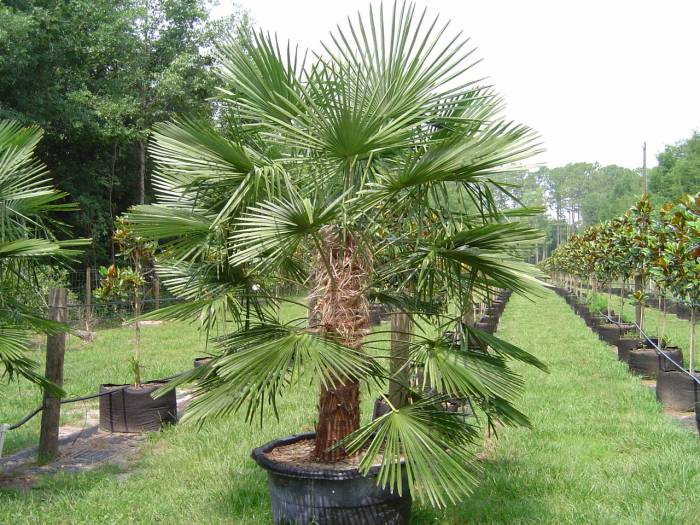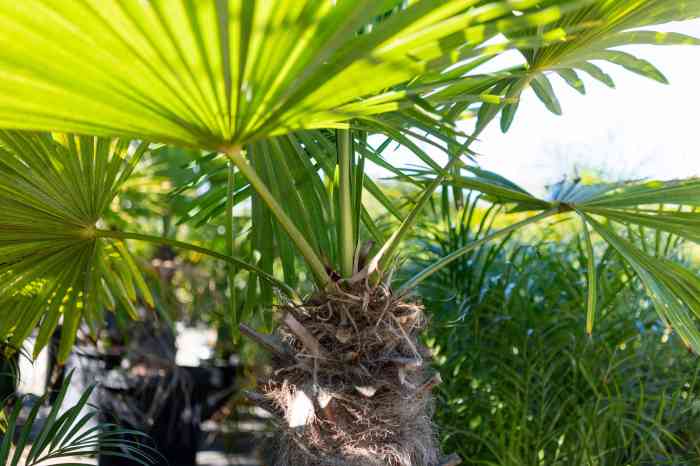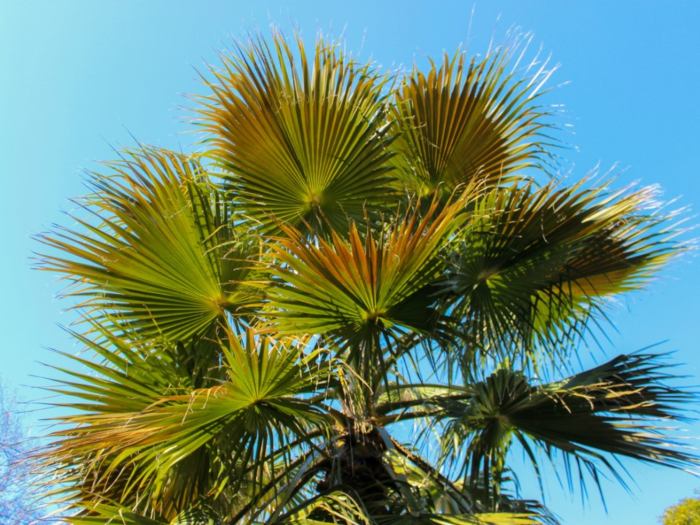Choosing the Right Windmill Palm

How to plant a windmill palm tree – Selecting the perfect windmill palm seedling is crucial for ensuring a healthy and thriving tree in your landscape. A carefully chosen seedling, free from disease and exhibiting strong growth characteristics, will significantly increase your chances of success. This section will guide you through the process of identifying a healthy seedling and selecting a variety appropriate for your climate.
Ideal Characteristics of a Healthy Windmill Palm Seedling
A healthy windmill palm seedling should display several key characteristics. Firstly, the trunk should be firm and free from any signs of rot or damage. The leaves, or fronds, should be a vibrant green, exhibiting a full and symmetrical shape. Avoid seedlings with brown or yellowing fronds, as this can indicate disease or stress. The roots should be healthy and well-developed, ideally appearing white or light brown and not exhibiting any signs of decay or damage.
A robust root system is essential for successful establishment in the ground. Finally, the overall appearance of the seedling should be vigorous and healthy, indicating a strong, well-established plant.
Planting a windmill palm is easy peasy, lemon squeezy! Just dig a hole, pop the palm in, and water generously. Thinking about other tropical plants? Check out this awesome guide on the pineapple plant or tree for some extra gardening inspiration! Then, get back to your windmill palm – make sure the soil’s nice and loose for happy roots!
Windmill Palm Varieties and Climate Suitability
Several windmill palm varieties exist, each with varying degrees of cold hardiness and tolerance to different environmental conditions.
- Trachycarpus fortunei*, commonly known as the Chusan palm or windmills palm, is a popular and widely adaptable species, known for its exceptional cold tolerance, thriving in USDA Plant Hardiness Zones 7-11. This makes it a good choice for many temperate regions. In contrast,
- Trachycarpus wagnerianus*, or the Wagner’s windmill palm, is a more compact variety, also exhibiting good cold hardiness, though perhaps slightly less than
- Trachycarpus fortunei*. For warmer climates, varieties adapted to higher temperatures might be more suitable, although
- Trachycarpus fortunei* demonstrates remarkable adaptability across a wide range of conditions. Careful consideration of your local climate and the specific hardiness of the chosen variety is paramount for successful cultivation.
Inspecting a Windmill Palm Seedling for Diseases and Damage
Before purchasing a windmill palm seedling, a thorough inspection is essential. Carefully examine the trunk for any signs of discoloration, soft spots, or lesions, all of which can indicate the presence of fungal diseases or pest infestations. Inspect the fronds closely for signs of yellowing, browning, or unusual spotting, which can signal nutrient deficiencies, disease, or insect damage.
Check the base of the trunk and the root system (if visible) for any signs of rot or damage. Avoid seedlings with damaged or broken fronds, as these can be vulnerable to further injury and disease. If any signs of disease or damage are detected, it is best to select a different seedling to minimize the risk of introducing problems into your garden.
Remember, a healthy seedling is the foundation for a thriving windmill palm.
Preparing the Planting Site

Successfully planting a windmill palm begins long before you ever touch a shovel. Proper site preparation is crucial for establishing a healthy, thriving tree that will grace your landscape for years to come. Neglecting this step can lead to stunted growth, susceptibility to disease, and even the death of your palm. Let’s delve into the specifics of preparing the perfect planting location.
Windmill palms, while relatively adaptable, prefer specific soil conditions for optimal growth. Understanding these preferences is key to their long-term health and aesthetic appeal.
Ideal Soil Conditions for Windmill Palms
Windmill palms thrive in well-draining soil that is slightly acidic to neutral. The ideal pH range is between 6.0 and 7.5. Poor drainage is a major problem, leading to root rot, a common cause of palm death. The soil should be loose and porous, allowing for adequate aeration around the roots. Heavy clay soils should be avoided or significantly amended.
Sandy loam is an excellent choice, offering a good balance of drainage and nutrient retention. If your soil is naturally heavy clay, amending it is crucial for success.
Preparing the Planting Hole
The size and depth of the planting hole are critical for establishing a strong root system. Dig a hole at least twice as wide and as deep as the root ball of your windmill palm. This allows for easy root expansion and minimizes root circling, a condition that restricts growth. For a palm with a 1-foot diameter root ball, aim for a hole approximately 2 feet wide and 1 foot deep.
The bottom of the hole should be loosened to improve drainage and encourage root penetration. Avoid planting too deeply; the top of the root ball should be level with the surrounding ground.
Amending Poor Soil
Many soils require amendment to achieve optimal drainage and nutrient content. Several materials can be used to improve soil structure and fertility. The choice of amendment depends on your soil type and the specific deficiencies.
| Amendment | Benefits | Application |
|---|---|---|
| Compost | Improves drainage, aeration, and nutrient content; adds organic matter. | Mix thoroughly into the planting hole at a rate of 1:1 with existing soil. |
| Perlite | Increases drainage and aeration in heavy clay soils. | Mix into the planting hole at a rate of 25-50% by volume, depending on soil type. |
| Coarse Sand | Improves drainage in heavy clay soils. | Mix into the planting hole at a rate of 25-50% by volume, depending on soil type. |
| Peat Moss | Improves water retention and soil structure; adds organic matter. (Use cautiously in well-draining soils). | Mix into the planting hole at a rate of 25% by volume, ensuring good drainage. |
Ongoing Care and Maintenance

Proper ongoing care is crucial for the long-term health and beauty of your windmill palm. Neglecting these essential steps can lead to weakened plants, susceptibility to pests and diseases, and ultimately, a shorter lifespan. This section details a comprehensive maintenance plan to keep your windmill palm thriving year after year.
Fertilizing Windmill Palms
Windmill palms benefit from regular fertilization, particularly during their active growing season. The best approach is a balanced feeding schedule that provides the necessary nutrients throughout the year. Avoid over-fertilizing, as this can damage the roots and negatively impact the palm’s health. A slow-release granular fertilizer is generally preferred to minimize nutrient burn. Here’s a sample fertilization plan:
- Spring (March-May): Apply a balanced granular fertilizer (e.g., 10-10-10) at a rate of 1 pound per 10 square feet of root zone. This provides a boost for new growth.
- Summer (June-August): Repeat the spring application, focusing on areas with visible new growth. Monitor the palm for any signs of nutrient deficiency (yellowing leaves, stunted growth).
- Fall (September-November): Reduce the fertilizer application to half the spring rate. This allows the palm to prepare for winter dormancy.
- Winter (December-February): Generally, no fertilization is needed during winter dormancy, as the palm’s growth slows considerably.
Always follow the instructions on the fertilizer packaging for precise application rates and safety precautions.
Common Pests and Diseases
While relatively hardy, windmill palms can be susceptible to certain pests and diseases. Early detection and prompt treatment are key to preventing serious damage.
- Scale Insects: These small insects attach themselves to the fronds, sucking sap and weakening the palm. Treatment involves manually removing visible scale, followed by application of insecticidal soap or horticultural oil.
- Mealybugs: Similar to scale, mealybugs are sucking insects that can cause yellowing and wilting of fronds. Treatment is similar to scale infestations – manual removal and application of insecticidal soap or oil.
- Fungal Leaf Spot: This disease manifests as brown or black spots on the fronds. Good air circulation and avoiding overhead watering can help prevent fungal leaf spot. Fungicides can be used for severe infestations.
- Ganoderma Root Rot: This serious fungal disease attacks the roots, leading to the eventual death of the palm. Unfortunately, there is no effective cure for Ganoderma root rot once it has established itself. Prevention through proper drainage and avoiding wounding the roots is critical.
Preventative Maintenance Schedule, How to plant a windmill palm tree
Regular pruning and removal of dead fronds are essential for maintaining the health and aesthetic appeal of your windmill palm. This preventative maintenance helps to reduce the risk of pest and disease infestations and encourages healthy new growth.
- Task 1: Dead Frond Removal (Monthly): Remove any brown or dead fronds using sharp, clean pruning shears. Cut the fronds as close to the trunk as possible to prevent disease.
- Task 2: Crown Cleaning (Annually): Remove any debris, such as dead leaves or accumulated dust, from the crown of the palm. This improves air circulation and reduces the risk of pest and disease problems.
- Task 3: Pruning (Every 2-3 Years): For shaping or to remove excessively dense fronds, carefully prune the palm, ensuring clean cuts to minimize damage and disease.
Troubleshooting Common Problems
Windmill palms, while relatively hardy, can experience several issues that impact their health and appearance. Understanding the causes of these problems and implementing appropriate solutions is crucial for maintaining a thriving palm. Early detection and intervention are key to preventing minor problems from escalating into significant threats to the palm’s survival.Yellowing leaves, stunted growth, and root rot are some of the most common problems encountered by windmill palm owners.
These issues often stem from improper planting, inadequate watering, nutrient deficiencies, or pest infestations. Addressing these issues requires a careful assessment of the palm’s environment and a tailored approach to treatment.
Yellowing Leaves
Yellowing leaves in windmill palms can indicate several underlying problems. Nutrient deficiencies, particularly magnesium and potassium, are common culprits. Overwatering or underwatering can also cause leaf yellowing. Furthermore, pest infestations, such as scale insects, can weaken the palm and lead to leaf discoloration. A visual inspection of the leaves, paying close attention to the extent and pattern of yellowing, can help pinpoint the cause.
For example, if yellowing starts at the older, lower leaves and progresses upwards, a nutrient deficiency is more likely. If the yellowing is patchy or accompanied by visible pests, an infestation is the probable cause. Treatment involves addressing the underlying cause; for nutrient deficiencies, applying a balanced palm fertilizer is recommended. For pest infestations, applying an appropriate insecticide or using a horticultural oil can effectively control the pests.
Stunted Growth
Slow or stunted growth in windmill palms often signals environmental stress or nutrient deficiencies. Poor drainage leading to root rot, insufficient sunlight, or compacted soil can all hinder growth. In addition, improper fertilization can also result in slow growth. To address stunted growth, examine the soil drainage, sunlight exposure, and the overall health of the root system.
Improving soil drainage, providing adequate sunlight, and using a high-quality palm fertilizer can stimulate growth. If root rot is suspected, careful pruning of affected roots may be necessary. In severe cases, repotting or transplanting might be required.
Root Rot
Root rot is a serious problem that can kill a windmill palm if left untreated. It is typically caused by overwatering, poor drainage, or soil that retains too much moisture. Symptoms include yellowing leaves, wilting, and a mushy, foul-smelling root system. Diagnosis involves examining the roots; affected roots will be brown, soft, and easily pulled away from the main root mass.
Treatment requires improving soil drainage, reducing watering frequency, and potentially applying a fungicide. In severe cases, it may be necessary to remove the palm from the pot or ground and replace the soil with a well-draining potting mix. Prevention involves ensuring the palm is planted in well-draining soil and avoiding overwatering.
Preventing Future Problems
Preventing problems is far easier than curing them. Proper planting in well-draining soil, regular fertilization with a balanced palm fertilizer, and consistent watering (avoiding both overwatering and underwatering) are crucial for maintaining a healthy windmill palm. Regularly inspecting the palm for signs of pests or diseases allows for early intervention, preventing minor issues from becoming major problems. Providing adequate sunlight and protecting the palm from extreme weather conditions will further enhance its resilience.
By proactively addressing potential issues, you can ensure your windmill palm thrives for years to come.
User Queries: How To Plant A Windmill Palm Tree
What if my windmill palm isn’t growing?
Check for root rot, insufficient sunlight, or nutrient deficiencies. Adjust watering, fertilization, and location as needed.
How often should I fertilize my windmill palm?
Generally, fertilize every 2-3 months during the growing season with a slow-release palm fertilizer. Adjust based on your palm’s needs and local climate.
My windmill palm has yellowing leaves – what’s wrong?
Yellowing leaves can indicate overwatering, underwatering, nutrient deficiency, or pest infestation. Investigate the root cause and adjust care accordingly.
Can I plant a windmill palm in a pot?
While possible, a larger pot (at least 20 gallons) is crucial for proper root development. Consider repotting as the palm grows.
